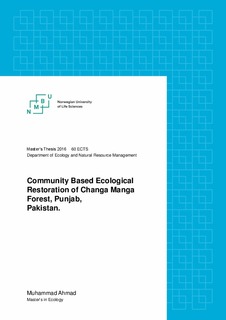| dc.description.abstract | Restoration ecology emerged as a separate field in ecology, and recently gained substantial attention due to global environmental changes and increased anthropogenic activities. The present research highlights the importance of ecological restoration of a 128 years old plantation named Changa Manga Forest in Pakistan. During the past few decades, this forest has undergone increased degradation through mismanagement, fires, illegal removal of trees and more, with almost 70% degradation compared to its original state at the time of partition of Pakistan (1947). Plantations play a significant role in the ecology and economy of countries like Pakistan, where forests and trees already are scarce and make up only about 4% of the total land area. I aimed to describe and characterize weather available tree/shrub species, their coverage and size could be used as a descriptive indicator of the state of a forest as either “intact” or “degraded”. In this study, the Changa Manga forest was investigated for signs of degradation, measured in terms of tree/shrub species count, density/cover and height. A total of five randomly selected regions were sampled through quadrat sampling in predefined “intact” and “degraded” habitats. I found significant differences (p ≤ 0.001) between intact and degraded habitats for all plant attributes (i.e., species count, density, diameter and height) studied. I found significantly higher values for intact than degraded habitat, indicating that degradation is a threat to the Changa Manga forest. Of the total 8 tree species recorded in the sampled plots, Eucalyptus (Eucalyptus microthyeca) and Shisham (Dalbergia sissoo) were found the most dominant, but both were rare in degraded habitats. These two plant species as such can be used as an indicator of degradation. The mean density of Eucalyptus in the intact habitat was significantly higher (16.68 individuals per 625m2) compared to degraded habitats (2.160 individuals per 625m2), indicating the severity of degradation. I also conducted qualatative interviews to gain insight into ongoing causes of degredation. During the last few decades, there have been many events of massive degradation of the forest in which the government officials were found guilty in some reports. The interview program provided a 94% response rate, highlighting the causes and some remedies for degradation of Changa Manga. Un-prescribed fire, water scarcity, corruption, lack of funds and improper management were found to be the main drivers of degradation. For the future ecological restoration and sustainability of this green resource, proper management, strict laws, increased community awareness, and proper ecological monitoring of restoration activities will be needed. | nb_NO |
